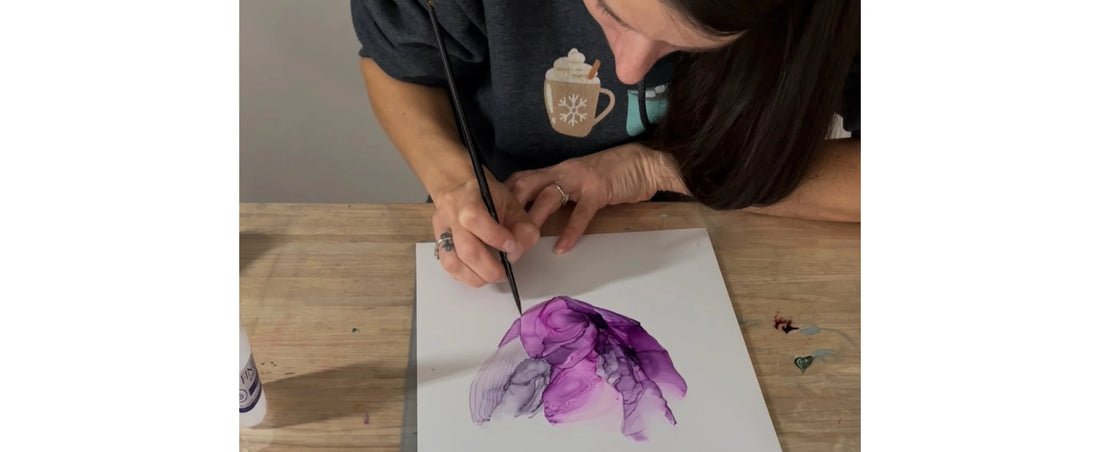Discover Alcohol Ink - Start here!

Share
Welcome to the vibrant realm of alcohol ink art!
Once shrouded in mystery, alcohol ink has become a captivating medium that I’ve slowly unraveled over time. If you’re drawn to the flow and radiant colors of alcohol ink, you’re in the right place. Whether you’re a seasoned artist exploring new horizons or a creative soul embarking on this artistic journey, this starter guide is tailored just for you.
Alcohol ink art has surged in popularity, thanks to its intense colors and fluid dynamics. For newcomers, diving into this medium can be both thrilling and overwhelming. To help you get started and create stunning pieces, here’s a beginner guide filled with essential tips and materials.
1. Gather Your Supplies
Before you begin your artistic adventure, ensure you have all the necessary supplies. Here’s a basic list to kickstart your journey:
- Alcohol Inks: Available in a spectrum of colors, from vibrant hues to delicate pastels.
- Isopropyl Alcohol: Preferably 91% or higher, used for cleaning and creating effects.
- Synthetic Paper: Nara and Yupo paper are popular choices. Opt for a non-porous surface.
- Brushes and Droppers: For precise application and manipulation of ink. I like to use a silicone brush as it doesn't absorb the liquid but moves it.
- Protective Gear: Gloves and a mask, and a well-ventilated workspace are essential.
- Dust Blower: To push the ink with ease.
- Varnish: To protect your artwork, as alcohol ink is quite sensitive.
While blending solutions are common, I’ve found that 99% isopropyl alcohol works best for my technique.
2. Understand Your Workspace
Alcohol inks can be messy and stain surfaces permanently. Prepare your workspace by covering it with a plastic sheet. Ensure you’re working in a well-ventilated area due to the strong fumes. Having a dedicated art space for your supplies and projects will enhance your creative experience and minimize stress.
3. Experiment with Techniques
Explore various techniques to find what resonates with you:
- Dropping and Blowing: Drop ink onto paper and use a straw or dust blower to manipulate it. Adding isopropyl alcohol can alter the movement.
- Layering: Apply multiple layers of ink to add depth and complexity.
- Blending and Lifting: Use isopropyl alcohol to blend colors or lift ink for intriguing patterns.
- Brush Work: Employ brushes for more controlled and detailed application.
Experimentation will help you discover your preferred techniques and develop your unique style.
4. Color Mixing Basics
Mastering color interaction is crucial. Begin with primary colors (red, blue, yellow) and mix them to create secondary colors (green, orange, purple). Utilize a color wheel to guide your mixing and avoid muddy results. Remember, alcohol inks are transparent, so layering can produce beautiful effects but requires careful color management.
5. Control the Flow
The fluid nature of alcohol inks is both unique and challenging. Control the flow by diluting ink with isopropyl alcohol or using your dust blower. The direction and intensity of the airflow will influence your artwork's final appearance.
6. Embrace the Unexpected
One of the most delightful aspects of alcohol ink art is its unpredictability. Allow the ink to flow freely and embrace the surprising effects. Some of the most captivating pieces come from spontaneous moments and happy accidents. If a piece doesn’t turn out as planned, set it aside and revisit it later with fresh eyes.
Still unsure about the design? Don’t let them go to waste! Check out this video for a creative idea on how to repurpose those beautiful remnants into a fresh and unique piece of art.
7. Find Inspiration Online
If you’re unsure where to start, visual inspiration can be incredibly helpful. Check out online tutorials, YouTube is gold for inspiration. Join my YouTube community here for video guides on creating beautiful flowers with simple techniques.
8. Seal Your Work
Once your artwork is dry, it’s important to seal it to protect the colors and prevent smudging. Avoid UV-resistant spray varnish for the first coat, as it often contains alcohol that can affect your ink. Apply several light coats for even coverage and to preserve the vibrancy of your colors.
Conclusion
Starting with alcohol inks opens up a world of vibrant possibilities. By gathering the right supplies, understanding your workspace, and experimenting with techniques, you can create stunning art that reflects your creativity. Embrace the unexpected and enjoy every moment of the process. Happy creating!
With Love, Josie.Ane
